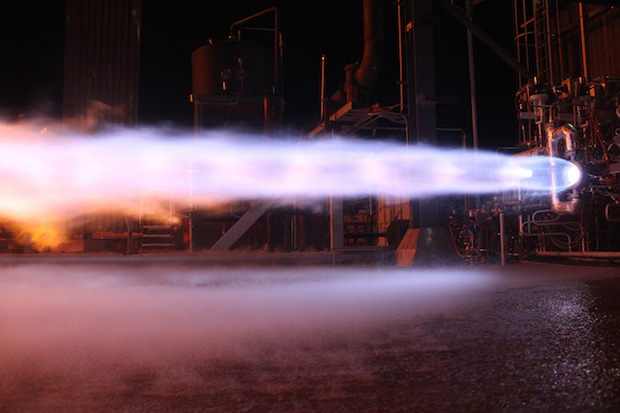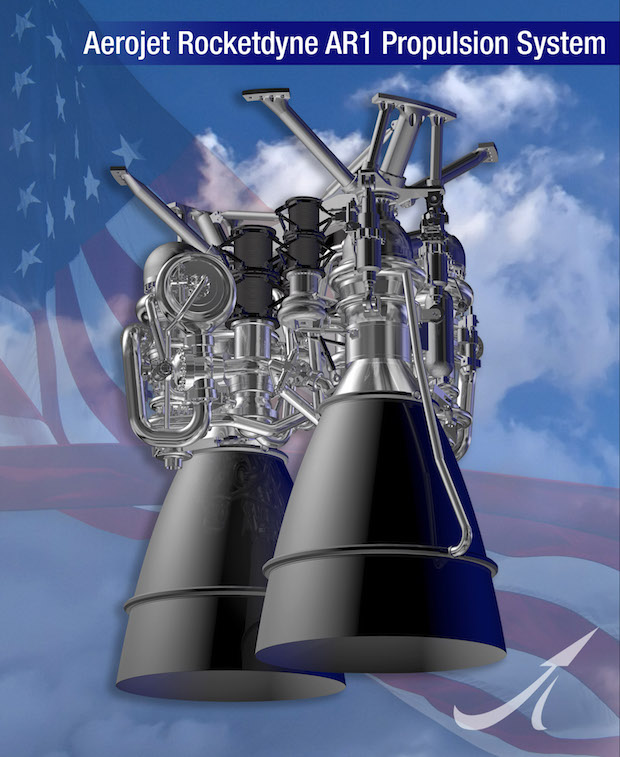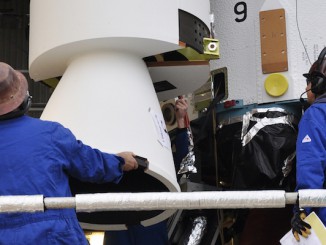
The Pentagon has awarded at least $162 million in contracts to Aerojet Rocketdyne and United Launch Alliance for development work on the AR1 and BE-4 rocket engines, candidates to power the first stage of a next-generation rocket and replace the Russian-made engine currently flying on the Atlas 5 launcher.
The awards announced Feb. 29 round out the U.S. Air Force’s initial investments in new rocket propulsion systems as the military seeks to move away from its reliance on the Russian RD-180 engine used on the Atlas 5, which launches most of the U.S. government’s satellites for secure communications, navigation and intelligence-gathering.
The Air Force is entering into public-private partnerships with Aerojet Rocketdyne and ULA, with each company putting up corporate funds to co-finance the engine development.
The agreement with Aerojet Rocketdyne covers design and testing of the AR1 rocket engine, a 500,000-pound-thrust class powerplant that burns a mixture of kerosene and liquid oxygen, the same propellants as the Atlas 5’s RD-180 engine.
Aerojet Rocketdyne aims to have the AR1 engine flight-qualified by 2019, with a first launch expected as soon as 2020.
“This award from the U.S. government demonstrates its support of AR1 and recognizes the priority of assured access to space for our critical national security assets,” said Eileen Drake, CEO and president of Aerojet Rocketdyne. “The AR1 engine is the option with the least technical risk that allows the United States to quickly and efficiently transition off its use of Russian-supplied engines currently used on the Atlas 5 launch vehicle.”
The Air Force has committed at least $115.3 million to the AR1 development program, while Aerojet Rocketdyne and ULA are jointly contributing an initial investment of $57.7 million, according to a statement released by Aerojet Rocketdyne.
Pending reviews and a government decision to continue support for the AR1 engine program, the agreement announced Feb. 29 has a maximum value of $804 million — with $536 million from the Air Force and $236 million from Aerojet Rocketdyne and ULA, the statement said.

“AR1 will return the United States to the forefront of kerosene rocket propulsion technology,” Drake said in the press release. “We are incorporating the latest advances in modern manufacturing, while capitalizing on our rich knowledge of rocket engines to produce a new, state-of-the-art engine that will end our reliance on a foreign supplier to launch our nation’s national security assets.”
The AR1 engine would include 3D-printed parts and operate with an oxygen-rich staged combustion cycle, a more efficient engine cycle than currently available on other U.S. liquid hydrocarbon rocket engines.
Aerojet Rocketdyne touts the AR1 as the most straightforward replacement for the RD-180 due to its propellant mix and size. Two of the AR1 engines would be required to meet — and slightly exceed — the performance of one dual-nozzle RD-180 engine on the Atlas 5.
But ULA wants to fly its next-generation Vulcan rocket with engines made by Blue Origin burning liquified natural gas, a fuel never before used on a large orbital-class launcher.
ULA executives say the BE-4 engine from Blue Origin, an entrepreneurial space firm founded by Amazon.com’s Jeff Bezos, will be ready sooner and will be easier to eventually recover and reuse.
The BE-4 engine is the focus of a separate Air Force cash infusion announced Feb. 29.
The Air Force is obligating at least $46.6 million to ULA for the next-generation Vulcan rocket, and ULA has agreed to initially add $40.8 million under the terms of the government award.
The lion’s share of the initial funding — $45.8 million — will go toward the BE-4 engine, which will generate 550,000 pounds of thrust and consume a cryogenic combination of liquified natural gas and liquid oxygen.
Two of the BE-4 engines would boost the Vulcan rocket’s first stage.
Officials say the BE-4 engine is fully funded by Bezos’s company, with help from ULA.
The Air Force funding “will enhance the company’s progress integrating the BE-4 engine with the Vulcan launch vehicle,” ULA said in a statement.
The government could put up to $201.7 million into efforts to match the BE-4 engine to the first stage of the Vulcan rocket, while ULA’s total potential investment under the umbrella of the agreement could be worth $134.2 million
“While the RD-180 engine has been a remarkable success with more than 60 successful launches, we believe now is the right time for American investment in a domestic engine,” said Tory Bruno, ULA’s president and CEO. “As America’s ride to space, we continue to meet our goal of delivering the most reliable launch systems at the most affordable cost, while developing a new rocket which enables brand new opportunities for the nation’s use of space.”
The BE-4 should finish its qualification testing in 2017 as ULA targets a maiden flight of the Vulcan rocket before the end of 2019.
Another $800,000 from the Air Force is earmarked for ULA’s advanced cryogenic upper stage, a centerpiece of the company’s long-term strategy that Bruno says will enable construction of in-space habitats for astronauts, deep space exploration and satellite servicing.
ULA is keeping the AR1 engine from Aerojet Rocketdyne as a backup option, with a final engine selection expected as soon as this year.
“ULA continues to work with both Blue Origin and Aerojet Rocketdyne to pursue two options for a next-generation American engine and that is why we’re teaming with two of the world’s leading propulsion companies,” Bruno said in ULA’s press release.
The Air Force’s financial commitments to Aerojet Rocketdyne and ULA unveiled Feb. 29 come after similar agreements announced in January with SpaceX and Orbital ATK.
The agreements started in January focus on SpaceX’s methane-fueled Raptor engine, with approximately three times the thrust of the company’s existing Merlin powerplants, and a new solid-fueled rocket motor for a large satellite launcher concept being designed by Orbital ATK.
New strap-on solid rocket boosters made by Orbital ATK for ULA’s Vulcan rocket, and a Blue Origin-built upper stage engine for Orbital ATK’s own proposed launcher also received funding.
Email the author.
Follow Stephen Clark on Twitter: @StephenClark1.



